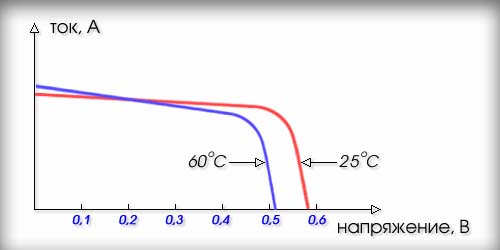
|
|
ENCYCLOPEDIA OF RADIO ELECTRONICS AND ELECTRICAL ENGINEERING Solar cells. Encyclopedia of radio electronics and electrical engineering
Encyclopedia of radio electronics and electrical engineering / Alternative energy sources Many of us do not suspect that the method of obtaining electricity from sunlight has been known for about 130 years. The photoelectric effect was first observed by Edmond Becquerel in 1839. This accidental discovery went unnoticed until 1873, when Willoughby Smith discovered a similar effect when a selenium plate was irradiated with light. And although his first experiments were far from perfect, they marked the beginning of the history of semiconductor solar cells. In search of new sources of energy, the silicon solar cell was invented at Bell Labs, which became the forerunner of today's solar photovoltaic converters. It was not until the early 50s that the solar cell reached a relatively high degree of perfection. Energy conversion in solar cells (PEC) is based on the photovoltaic effect in inhomogeneous semiconductor structures when exposed to solar radiation. On this page, we do not set ourselves the goal of going into the physics of this difficult phenomenon, so we will briefly describe the practical side of the matter. You can use the energy of solar cells in the same way as the energy of other power sources, with the difference that solar cells are not afraid of short circuits. Each of them is designed to maintain a certain current strength at a given voltage. But unlike other current sources, the characteristics of a solar cell depend on the amount of light falling on its surface. For example, an incoming cloud can reduce output power by more than 50%. In addition, deviations in technological regimes entail a spread in the output parameters of the elements of one batch. Therefore, the desire to get the most out of photovoltaic converters leads to the need to sort cells by output current. As an illustrative example of "a lousy sheep that spoils the whole herd", the following can be cited: cut a pipe section with a much smaller diameter into a break in a large-diameter water pipe, as a result, the water flow will drastically decrease. Something similar happens in a chain of non-uniform output parameters of solar cells. Silicon solar cells are non-linear devices and their behavior cannot be described by a simple formula like Ohm's law. Instead, to explain the characteristics of the element, you can use a family of easy-to-understand curves - current-voltage characteristics (CVC)
The open-circuit voltage generated by one element changes slightly when moving from one element to another in one batch and from one manufacturer to another and is about 0.6 V. This value does not depend on the size of the element. The situation is different with current. It depends on the intensity of the light and the size of the element, which refers to its surface area. An element with a size of 100 * 100 mm is 100 times larger than an element with a size of 10 * 10 mm and, therefore, under the same illumination, it will give out a current 100 times greater. Loading the element, you can plot the dependence of the output power on the voltage, getting something similar to that shown in Fig. 2
The peak power corresponds to a voltage of about 0,47 V. Thus, in order to correctly assess the quality of a solar cell, as well as to compare the cells with each other under the same conditions, it is necessary to load it so that the output voltage is 0,47 V. After the solar elements are selected for work, it is necessary to solder them. Serial elements are equipped with current-collecting grids, which are designed for soldering conductors to them. Batteries can be made in any desired combination. The simplest battery is a chain of series-connected cells. It is also possible to connect chains in parallel, obtaining the so-called series-parallel connection. An important point in the operation of solar cells is their temperature regime. When the element is heated by one degree above 25оWith it, it loses 0,002 V in voltage, i.e. 0,4%/degree. Figure 3 shows a family of CVC curves for temperatures 25о C and 60о C.
On a bright sunny day, the elements heat up to 60-70оWith losing 0,07-0,09 V each. This is the main reason for the decrease in the efficiency of solar cells, leading to a drop in the voltage generated by the cell. The efficiency of a conventional solar cell currently ranges from 10-16%. This means that an element with a size of 100 * 100 mm under standard conditions can generate 1-1,6 watts. The following are recognized as standard conditions for the certification of elements around the world: - illumination 1000 W/m2 - temperature 25оС - spectrum AM 1,5 (solar spectrum at latitude 45о) Publication: alternativenergy.ru
Alcohol content of warm beer
07.05.2024 Major risk factor for gambling addiction
07.05.2024 Traffic noise delays the growth of chicks
06.05.2024
▪ Words and their emotional coloring
▪ section of the site Aphorisms of famous people. Article selection ▪ article by Leonardo da Vinci. Famous aphorisms ▪ article How did science originate? Detailed answer ▪ article Spy stuff. Directory
Home page | Library | Articles | Website map | Site Reviews www.diagram.com.ua |






 Arabic
Arabic Bengali
Bengali Chinese
Chinese English
English French
French German
German Hebrew
Hebrew Hindi
Hindi Italian
Italian Japanese
Japanese Korean
Korean Malay
Malay Polish
Polish Portuguese
Portuguese Spanish
Spanish Turkish
Turkish Ukrainian
Ukrainian Vietnamese
Vietnamese



 Leave your comment on this article:
Leave your comment on this article: